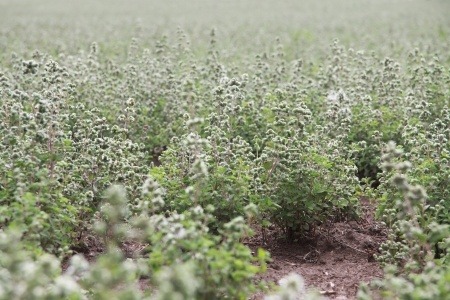
Marjoram (Origanum majorana L.) in culinary terms is often used as a replacement for oregano and imparts a similar but slightly more acidic flavour to pasta dishes. Elizabeth David, in her book on French Provincial Cooking (1960) describes marjolaine as it is known in France, as a stuffing and herb for stews which is used more commonly in England to flavour sausages. If you want to know how to grow this herb take a look at this article which gives a simple description of how to do it easily.
Antimicrobial Properties
The extract has some antibacterial/antifungal properties when examined, as a stimulant, e.g. sweating (a sudorific), to induce blood flow in the pelvic area (an emmenagogue), as a promoter of lactation (a galactogogue) and in the amelioration of anxiety sited disorders (Farooqi and Sreeramu, 2004).
The extracted plant oil was tested for antifungal and antibacterial activity (Ben et al., 2001; Farooqi and Sreeramu, 2004). One early study showed the following (Deans and Svoboa, 1990):- a steam distilled volatile oil was evaluated against a range of 25 bacterial and five fungal species. It included animal and plant pathogens, food poisoning bacteria and mycotoxigenic fungi. The oil exerted considerable inhibitory powers against several of the bacteria, with the food-poisoning bacterium Staphylococcus aureus being least affected. The most susceptible organisms were Beneckea natriegens, Erwinia carotovora and Moraxella sp. Of the fungi tested, Aspergillus niger proved the most susceptible to marjoram oil. Similarly, agar diffusion and broth microdilution was used to assess marjoram oil against 10 microbial strains and the most susceptible were Escherichia coli, Streptococcus A, Shigella dysenteria and Salmonella enteritidis but the least susceptible was Pseudomonas aeruginosa (Ezzeddine Nejla et al., 2001).
Marjoram has reputedly, some antioxidant activity. An early study assessed methanolic extracts which were tested for antioxidant activity in comparison with other well known herbs such as Rosemary and Sage but Marjoram did not have the same efficacy as these other herbs in reducing autooxidation of lard stored at a relatively high temperature – 75 °C. (Economou et al., 1991).
References
Ben, H. E. N., M. M. Abdelkefi, R. B. Aissa and M. M. Chabouni (2001) Antibacterial screening of Origanum majorana L. oil from Tunisia. J. Ess. Oil Res., 13, pp. 295-297
Deans, S. G. and Svoboda, K. P. (1990), The antimicrobial properties of marjoram (Origanum majorana L.) Volatile Oil. Flavour Fragr. J., 5 pp. 187–190. doi: 10.1002/ffj.2730050311
Economou, K.D., Oreopoulou, V., Thomopoulos, C.D. (1991) Antioxidant activity of some plant extracts of the family Labiatae. JOACS 68 (2) pp. 109-113
Farooqi, A. A. and B. S. Sreeramu (2004) Cultivation of medicinal and aromatic crops. Universities Press, India. pp. 465-470.

What’s the difference between it and oregano ? We use loads of marjoram it in our cooking but I’d like to try it in our sauces – any flavour or other benefits possible. I used it instead of basil the other day for a tomato sauce but it seemed a bit too acid like. Come over to the Red Lion as we are on your way to Abergavenny. We noticed Walnut Tree were using a lot more marjoram in their dishes too – when we ate their back in December.
I find this herb grows so much more easily than oregano but I lose the flavour on drying. I started using a domestic dehydrator which seems to be the best way forward but I really miss that slightly acidic note you have. Its great with tomatoes and I use it as a pesto with spaghetti.